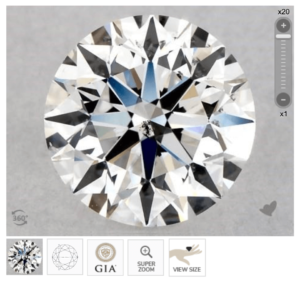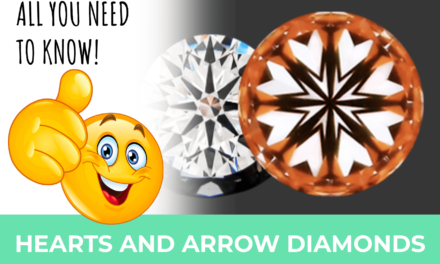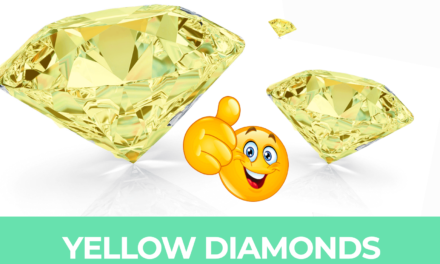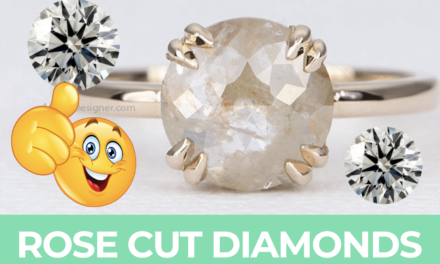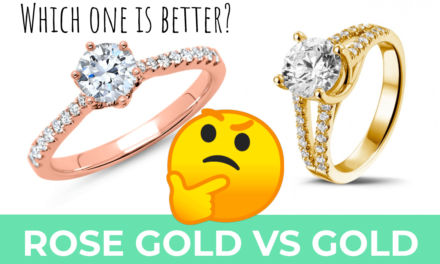My website is reader-supported. Buying through links on my site may result in me earning a CUSTOMER REFERRAL FEE at no extra cost to you.
Check out the latest deals at our top diamond vendor choice: James Allen
G color diamond – when it is a good choice and when not
G color loose diamond, 1.03ct, ideal cut quality, SI1 clarity grade
Are you thinking of buying an engagement ring? If so, you may be wondering if a G color diamond is a good choice. This blog post will look at what G color diamonds are and what to consider when choosing one. I’ll also provide some tips on how to get the best deal on a G-color diamond engagement ring.
So, whether you’re already set on getting a g color diamond or are just starting to do your research, read on for everything you need to know about these beautiful gems!
Content overview
- What is a G color diamond?
- Some basic facts about diamond color
- Where G falls on the GIA color scale
- Is a G color diamond good enough for engagement rings?
- How much does a G color diamond cost?
- When is a G color diamond the best choice? Ring Setting & Color Grade Recommendations
- Conclusion
VVS1 Diamond Summary
- Diamond color refers to the presence or absence of color and is graded on a scale from D to Z, with D being a colorless diamond
- A G color diamond is in the near-colorless range, representing a relatively high color grade
- A G color diamond can be more than 30% cheaper than a D color diamond, making it a popular choice for engagement rings with a white gold setting
- For people who consider a yellow gold setting, I recommend lower grades, as you won’t be able to see a color difference with the naked eye and can save more money
- The best places to shop for G diamonds are James Allen and Blue Nile
What is a G color diamond?
The Gemological Institute of America (GIA) grades a diamond’s color on a scale from D to Z, with D being the most colorless and Z being the most yellow. They then group these grades together in various color ranges, such as colorless, near colorless, faint yellow, very light yellow, and light yellow.

A diamond with a color grade of G is at the top of the “Nearly Colorless” range and only exhibits a faint yellow tint. Other diamond colors in the nearly colorless diamonds include an H color diamond, I and J.
G color diamonds are trendy because they offer a beautiful, subtle appearance that is still very sparkly. They are also more affordable than diamonds in higher color grades, making them an excellent option for those on a budget.
However, you can opt for even lower color options to save money in many cases.
Basic facts about diamond color
A jeweler determines a diamond’s overall value in part on an absence of color (colorless). A D, E, or F color diamond is sometimes referred to as a white diamond. That doesn’t mean they are white, but they are fully transparent like glass and exhibit no body color. G color diamonds look very similar to colorless stones.
Generally speaking, the higher the color grade, the more valuable the diamond. That’s because a whiter diamond is rarer and more sought after.
However, there are some cases where a lower color grade diamond may be more desirable. For instance, if you are looking for a diamond to set in a piece of jewelry with gilding or other yellow accents, you may want to choose a diamond closer to the Z color range. This will help it stand out against the background and create a beautiful contrast.
On the other hand, you might want to opt for a G diamond or even higher color grade in some instances. For instance, that would be choosing a very bright ring setting, a certain diamond shape, or a very high carat weight.
Diamond Color Scale
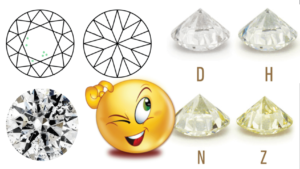 The Gemological Institute of America (GIA) is the most prestigious diamond grading organization issuing reports on diamonds.
The Gemological Institute of America (GIA) is the most prestigious diamond grading organization issuing reports on diamonds.
When you’re buying a diamond, I highly recommend that you request a GIA certificate for each diamond you’re considering due to the broad range of colors you’ll likely see.
The GIA grading scale for diamond Color is below:
Colorless

A color grade of D is the highest, so these diamonds have almost no color. They look colorless when seen by the naked eye and under magnification. E and F color stones look nearly identical when seen by the naked eye. It takes an expert gemologist to distinguish between D, E, and F color diamonds.
D-F diamonds are typically set in white gold or platinum, as yellow gold or other metal settings would detract from the colorless quality of the diamond.
Near Colorless Range

Color G-J exhibit almost no color and look colorless to the naked eye. Although there may be a hint of color, these diamonds look best set in white gold or platinum due to the possible reflection of yellow gold on the diamond.
G-J diamonds are not as rare as D-F diamonds, so they cost less. In this range of nearly colorless stones, prices go down by about 10%-15% per grade, but they may not look any different when seen by the naked eye.
Faint Tint

K-M color grades show a tiny hint of yellow when you look at it with the naked eye. People sometimes prefer the warmer tone in a magnificent yellow gold setting.
Due to their perceivable hint of color, diamonds falling in this color range often cost 50% less than G-I graded diamonds.
Very Light Tint & Light Tint

N-R color graded diamonds have a yellow to brown tone that you can see with the naked eye, and therefore, many vendors offer them at much lower prices.
I recommend that you avoid N-R color-graded diamonds.
S-Z color diamonds have a noticeable yellow or brown tone. This is why I do not recommend that you buy S-Z colored diamonds.
Engagement ring diamonds are typically in the nearly colorless range and may exhibit a slight yellow tint or brownish tone. The diamond’s setting can change how the diamond’s color is perceived, as does the lighting where the stone is being shown. It would be best to keep these factors in mind when evaluating the color of any diamonds.
Is a color G diamond good enough for engagement rings?
G-colored diamonds are nearly colorless, which means that you can detect only a tiny hint of yellow (if at all). This is not easy to see unless you make a side-by-side comparison with diamonds of a higher color grade. G color diamonds provide great value and look stunning in white gold or platinum settings. It is ok to pair a G color diamond with white metal.
Even if you buy a diamond with high carat weight, such as 3 carats, you’ll still be happy with a G color diamond. The same applies to emerald-cut diamonds.
How much do G color diamonds cost?
G color diamonds can be much less expensive than a colorless diamond. The difference can be hundreds or even thousands of dollars in comparing prices.
G color diamonds are less expensive because they have a higher level of color or cloudiness compared to diamonds with colorless grades. However, that isn’t usually a problem for the diamond’s beauty or value.
Below I’m comparing some real-life examples of diamonds of varying color (with all other parameters being the same):
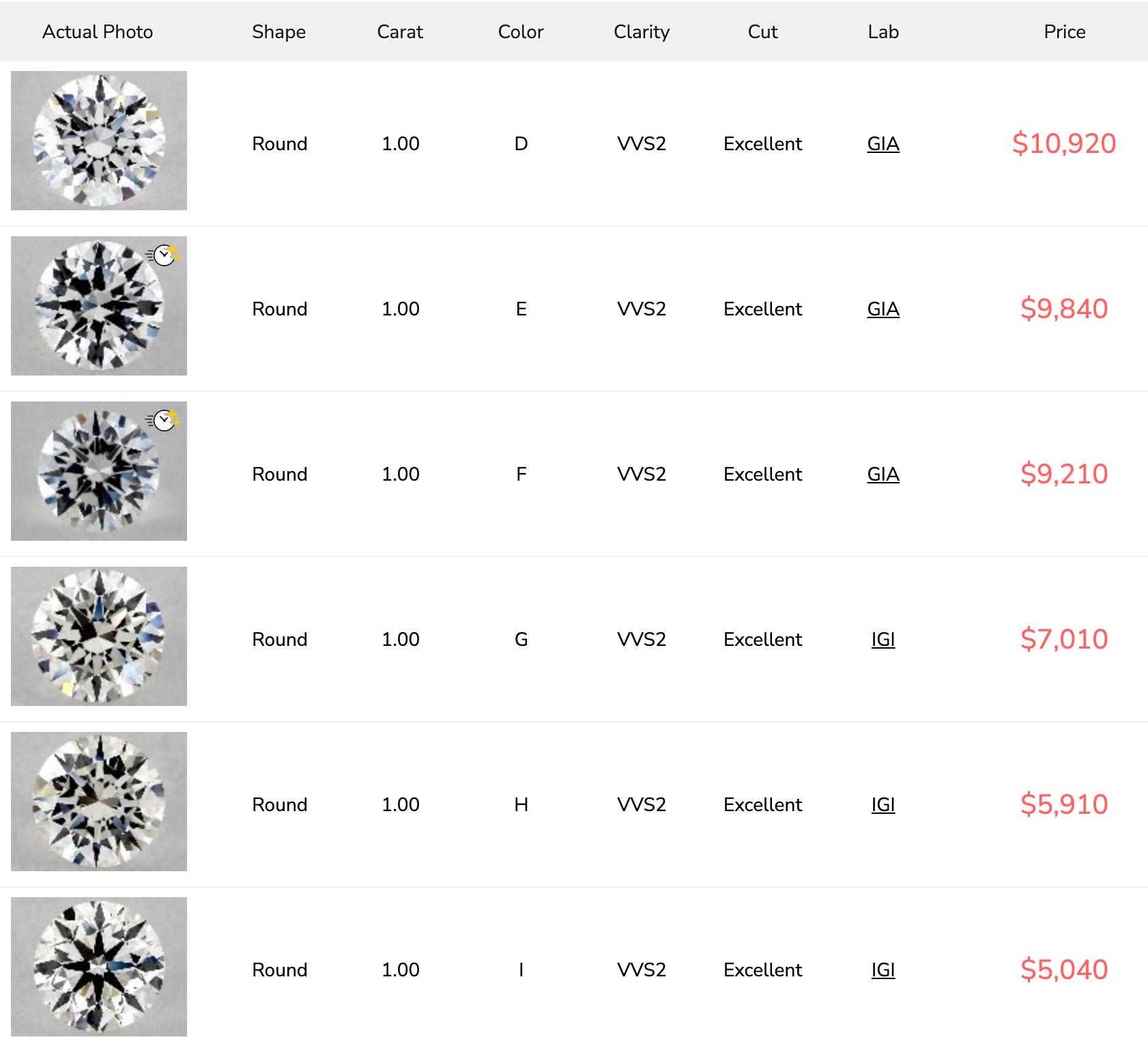
As you can see, in the diamond pricing chart below, the price goes up significantly with each color grade. A D-color-diamond can be as much as 36% more expensive than a G-color-diamond!
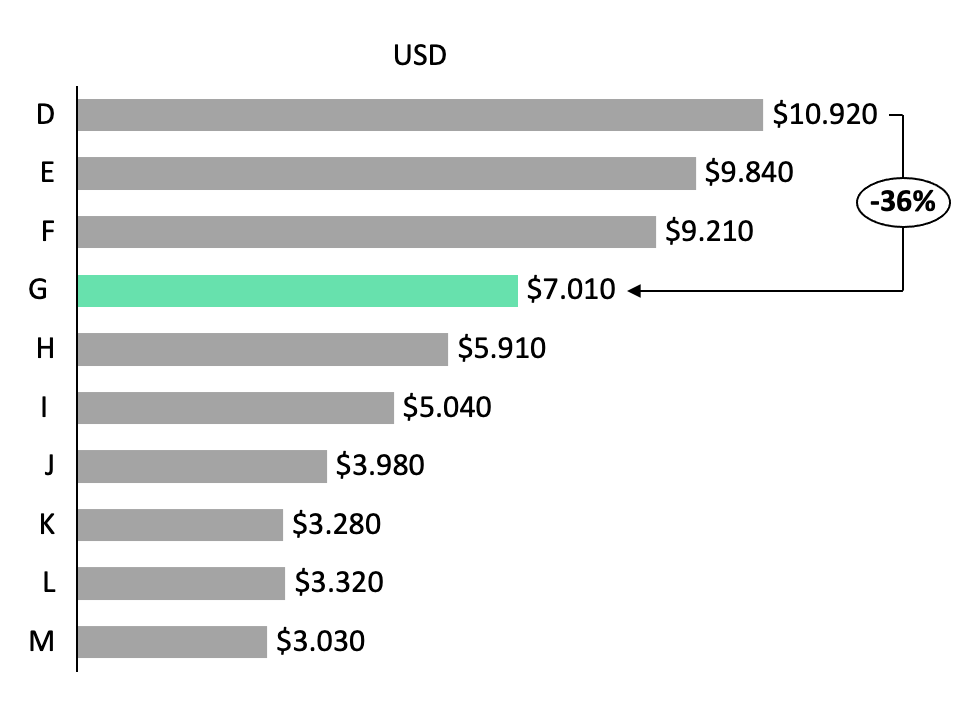
Shoppers looking for a bargain should consider g-color diamonds as a viable option. And in certain cases it might even make sense to choose a lower color grading.
When is a G color diamond the best choice? Ring Setting & Color Grade Recommendations
Solitaire diamond in white gold or platinum ring setting
If you select a round brilliant cut diamond with a higher color grade than H, you will pay for a feature that you cannot see with the naked eye, so it makes no practical sense. If you want to get the best value for your hard-earned money, I’d recommend the following color grades for a diamond with a carat weight below 2:
- Round Cut: H-J color.
- Asscher, Emerald, or Princess Cut: G-I color.
- All Other Cuts: F-H color.
Solitaire diamond in a yellow gold ring setting
The yellow-gold color of the setting is reflected onto the diamond, so any color grade above K would still appear slightly yellow. The darker color of a yellow gold setting allows you to cut down the price tag quite a bit:
- Round Cut: K-M grades.
- Princess, Emerald, Asscher: J-K grades.
- All other Diamond Shapes: I-J grades.
- For Halo Settings – All Diamond Cuts: F-H grades.
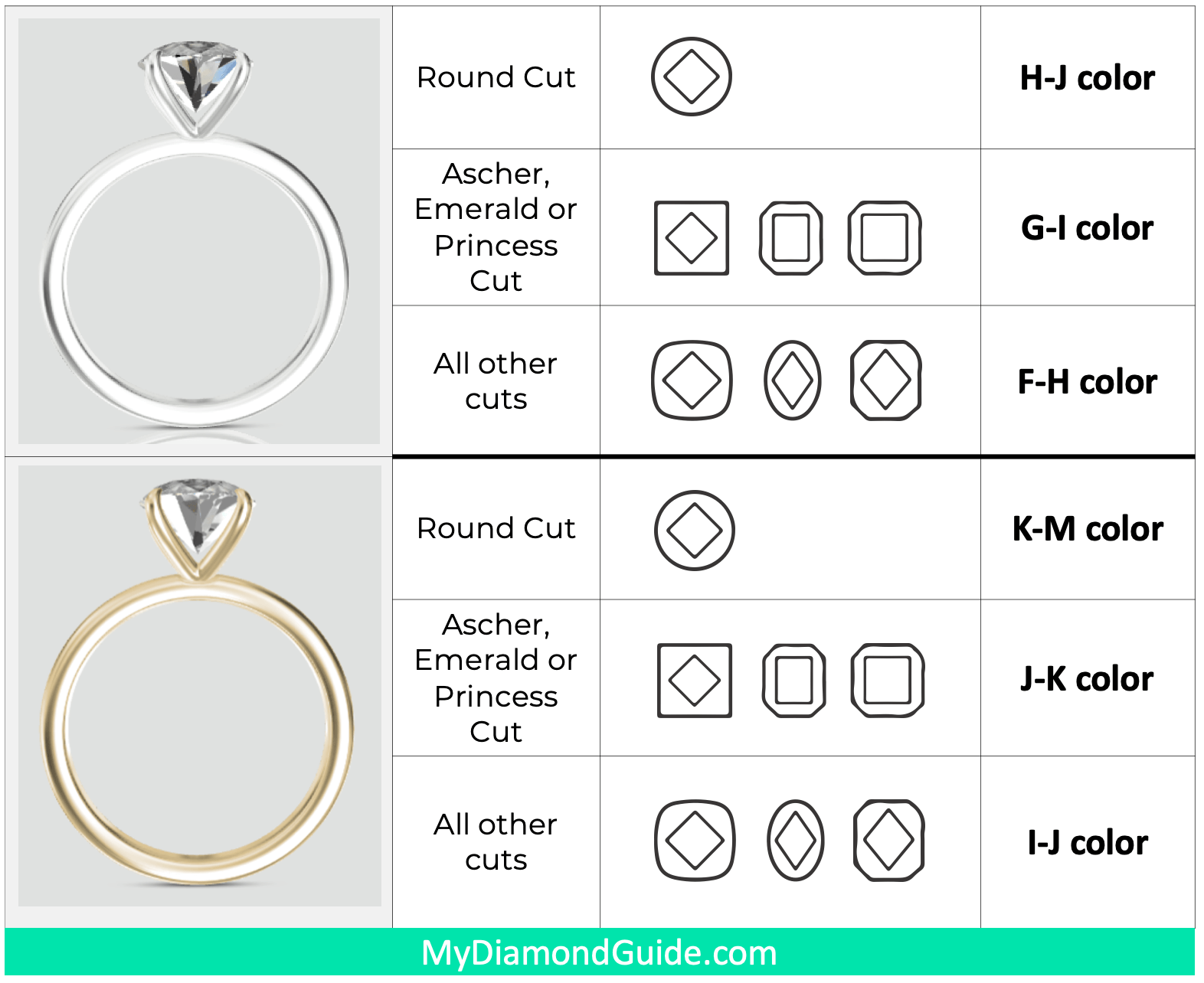
Where should I shop for G color diamonds?
If you are looking for a high-quality G-colored diamond, I recommend you go online to James Allen. James Allen is a reputable and popular online diamond retailer that sources its stones from the top diamantaires in the industry. Since they own their diamonds, you will not see any middlemen markups on their site, allowing them to offer up some of the lowest prices available for such high-quality diamonds (G color +).
Another option that I highly recommend is Blue Nile. Blue Nile is also an online diamond retailer, but they offer a slightly different buying experience than James Allen. Blue Nile offers a more traditional diamond shopping experience where you can also view diamonds in person at one of their eight showrooms in the US before making your purchase (although I don’t think that is necessary since you can see more details online with their super zoom function).
Whichever retailer you choose, be sure to ask for a G color diamond grading report from the American Gem Society (AGS) or the Gemological Institute of America (GIA). This will ensure that you are getting a high-quality diamond that is graded accurately.
Conclusion
If you are looking for a white gold ring setting, it may be time to consider a G color or H color diamond. They are in the near-colorless range and more affordable than diamonds in the colorless range. Lower color grades can also work well for darker settings or small stones. I would recommend shopping for these types of diamonds at James Allen if you haven’t already– they have an excellent selection!

